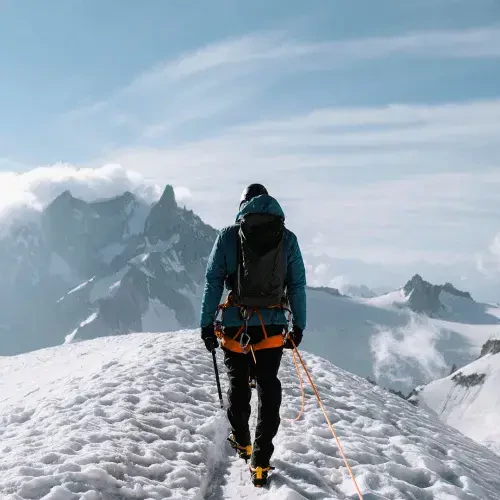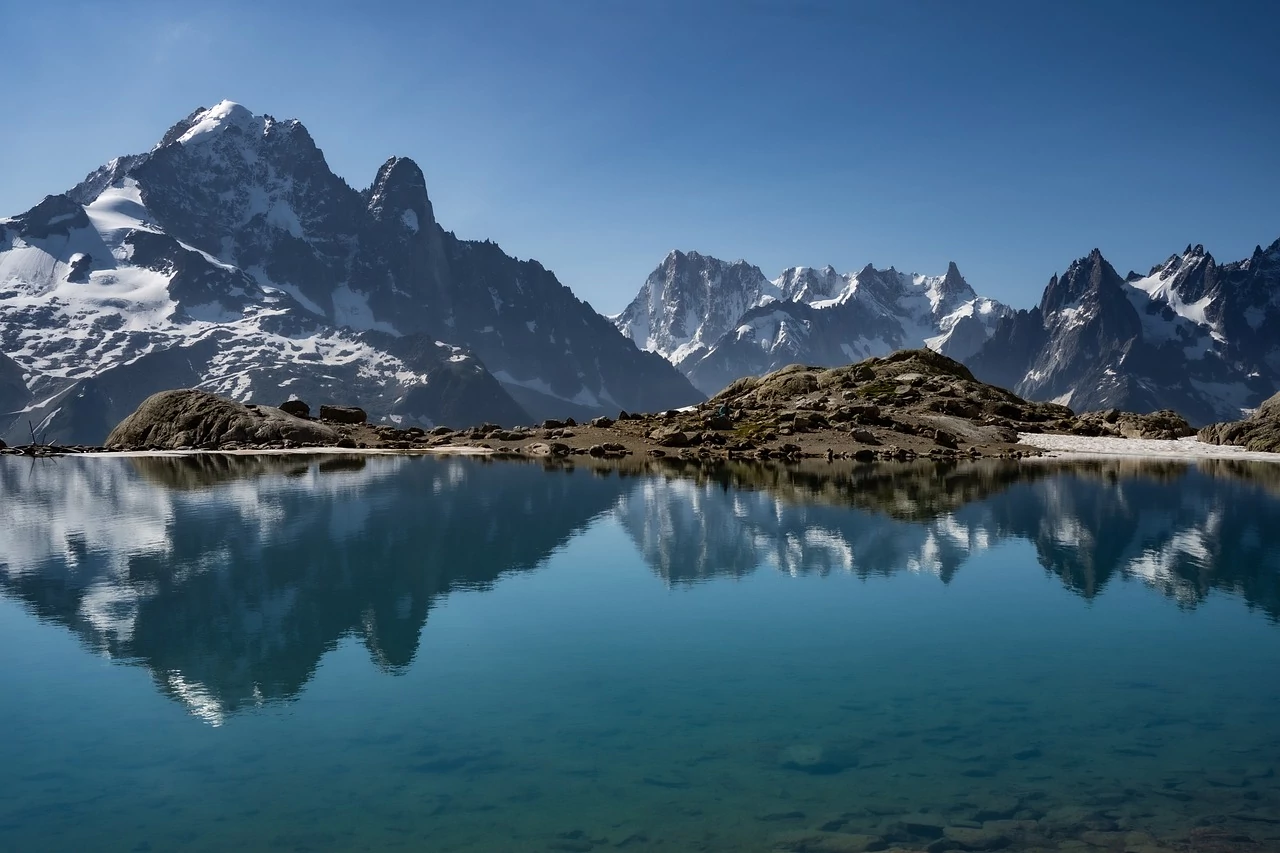What is mountaineering and how do you go about it in Chamonix?
Mountaineering is a mountain ascent that can range from glacier trekking to more technical routes: rock faces or ice corridors.
Depending on your experience, you can set off on your own or with a mountain guide.
In Chamonix, several schools and guides offer supervised courses for all levels. Your guide will advise you and guide you along the most suitable route for the day, depending on the weather and your individual abilities. Mountain sports are demanding because of the altitude. A mountaineering course requires you to be in good physical condition.
For beginners, the guide's advice makes it easier to adapt gradually to this demanding environment. For a one-day or multi-day course, it's essential to know yourself well to avoid incidents during the climb: headaches, nausea, etc.
Every course requires thorough preparation : knowing the route, checking the weather conditions for each day and making sure you have all the equipment you need. Sanglard Sports hires out mountaineering equipment and gear in Chamonix for all ages and abilities.

Chamonix: the ideal destination for discovering mountaineering
Chamonix is often referred to as the ‘mountaineering capital of the world’, with its many and varied routes. The peaks of the Mont-Blanc massif and the Aiguilles Rouges are perfect for a high-mountain immersion course, offering a wealth of unique routes.

A safe and efficient transport infrastructure guarantees you the best possible experience: cable cars, gondolas, trains. Discover why Chamonix is the ideal destination for mountaineering.
A variety of routes
Chamonix offers a multitude of climbs to suit everyone.
Beginners can try their hand at climbing the Aiguille du Tour, with its breathtaking views of Mont Blanc.
For more experienced climbers, technical routes such as the traverse of the Aiguille d'Entrèves or the ascent of the Aiguille Verte offer stimulating challenges.
Glaciers, rocky ridges, corridors of snow and ice and vertiginous walls - there's a challenge for everyone.
High-quality facilities
Chamonix has a wide range of facilities to facilitate mountaineering courses.
The Aiguille du Midi cable car and the Brévent cable car provide rapid access to the high mountain areas.
Walkers can take the Montenvers train to admire the famous Mer de Glace.
Well-equipped mountain refuges are strategically located throughout the Mont-Blanc massif. They are essential rest points for multi-day ascents.
A large alpine community
Every day, mountaineers from all over the world venture around Chamonix. A rich community, united by a common passion, comes together in this region for courses and climbs together.
By choosing Chamonix, you benefit from these unique encounters and experiences. The opportunity to improve your skills with guides and enthusiasts.
Experienced mountain guides
Chamonix's guides are among the best in the world. Many of them grew up in the mountains and were teenagers when they climbed their first summit.
Their knowledge of the terrain and their experience ensure safe journeys, particularly on technical routes. Whether you're a beginner or an experienced mountaineer, hiring a guide for a course lasting one or more days is a great way to ensure a successful stay in the mountains.
What mountaineering equipment do you need?
Equipment is a crucial element in mountaineering. To anticipate risks, you need to choose the right equipment: clothing, footwear, accessories, etc.
This equipment must be adapted to the conditions and the planned route. Here is the essential equipment for a mountaineering course in Chamonix.
What should you wear when mountaineering?
Weather conditions are changeable in the high mountains. To adapt as best they can, mountaineers opt for technical, lightweight and breathable clothing.
-
Base layers : This first layer helps to keep the body dry when it perspires, thereby maintaining warmth. Technical underwear made from synthetic fibres or merino wool are the most suitable materials.
-
Intermediate layers : Intermediate layers retain body heat and insulate against the cold outside. One or more layers of fleece or down (down jacket) are ideal for coping with temperature changes right up to the summit.
-
Outer layer : The outer layer is used to protect the mountaineer from bad weather: wind, rain, snow, etc. A waterproof and windproof Gore-tex jacket is an effective way of protecting yourself.
-
Bottoms : Depending on the altitude, mountaineers can make do with waterproof, breathable Gore-Tex mountain trousers. In cold weather, we recommend leggings in merino wool or thermal fabric. Gaiters and a pair of warm socks complete this equipment.
-
Accessories : warm gloves, hat, choker and sunglasses or ski mask to protect against the cold and UV rays.
Mountaineering boots and crampons
Mountaineering boots must hold, insulate and be compatible with crampons. The aim is to ensure a good fit whatever the terrain, but also to protect the feet and ankles from falling rocks or unevenness. Waterproof, rigid or semi-rigid Gore-tex boots with a stone guard and Vibram sole are recommended.
Crampons should be adapted to the conditions of the race (snow, ice, mixed). Choose crampons with 10 or 12 points, in steel or aluminium, depending on the terrain. Automatic or semi-automatic crampons are easier to use. In all cases, it's important to check that the attachment system is compatible with your boots.
Ice axes and poles
Ice axes are important for progress and safety in mountaineering. Comprising a shaft, a head and a pick, this technical tool has several uses.
There are three main types of ice axe to choose from : classic, technical and traction. The length should be adapted to your height and intended use :
-
For beginners doing less technical ascents, a straight ice axe that can be used as a walking stick is best.
-
More experienced mountaineers looking for more challenging peaks may prefer one or two all-terrain ice axes or two technical ice axes for ice climbing.
Trekking poles are useful for taking the strain off muscles and joints during long journeys. On technical passages, or difficult surfaces such as snow, mud or scree, they increase safety, maintain balance and reduce the risk of falls and injuries.
Telescopic poles are practical because they can be adjusted in length and stored easily.
Helmets
Helmets are essential to protect your head from falling rocks, ice and falls.
While the strength of the helmet remains the most important factor, a light, well-ventilated model will provide greater comfort during your climbs. Polycarbonate models with EPS foam, complying with standard EN 12 492, are the most commonly used.
To get the most out of your helmet, make sure it is properly adjusted before you start your run. It needs to be comfortable and stable so that you don't have to keep putting it on during your ascent. Finally, check its condition regularly to ensure that it is still functional (particularly if it is hit by a falling object or rock).
Ropes and harness
Ropes and harnesses are essential safety equipment in mountaineering. They are used in particular on glacier and wall ascents.
We recommend that you use dynamic 60-70 metre ropes for climbing and twin or double ropes for glacier tours. To prevent damage, these ropes are treated for use in a damp environment. Rope diameter varies according to use. Generally between 8 and 10 mm, it's best to opt for a ‘thick’ rope when you're just starting out, so that you can feel secure with this equipment.
A harness is a piece of personal protective equipment for safe vertical climbing. Its manufacture is governed by standard EN 12 277. For optimum use, choose a harness that is comfortable, lightweight and adjustable. Make sure it has enough gear loops to carry all your equipment.
Rucksack
The rucksack should be adapted to the conditions of the race. For a first mountaineering course, it is not necessary to have a specialised rucksack, which may represent an investment.
More experienced mountaineers wishing to spend several days traversing the Chamonix valley will need technical equipment. There are two main parameters :
-
Capacity : For a one-day trip, a 20-40 litre bag is sufficient. For a course lasting several days, opt for a 50-60 litre bag.
-
Features : Choose a bag with a streamlined design to avoid excess weight, with compression straps, an ice axe holder and accessible pockets. This equipment must be comfortable.
Essential accessories
As well as the basics, there are a number of accessories that are essential for a safe and comfortable mountaineering trip. Checklist of essential accessories :
-
Spare pair of gloves, neck strap
-
Headlamps
-
First aid kit, multi-purpose knife, survival blanket, compression bandages
-
Maps, hiking GPS
-
Water, high-calorie foods to ensure you have enough energy
-
Sun cream, lip balm, sunglasses
Mountaineering in Chamonix is an unforgettable experience, accessible to everyone.
Whether you're an experienced mountaineer or a beginner, the Chamonix valley offers exceptional opportunities to indulge in this demanding discipline. Thanks to Sanglard Sports equipment and the advice of local guides, you can make the most of your trip to the summits of the Alps in complete safety.









